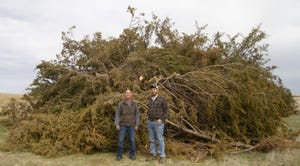Smithsonian Museum Will Focus On Agriculture
Agriculture is new focus of Smithsonian’s National Museum of American History.
March 19, 2013

On National Agriculture Day, the Smithsonian's National Museum of American History unveiled a new website where the public can upload stories about technologies and innovation that have changed their work lives in agriculture -- stories about precision farming, food-borne illness tracking, environmental concerns, government practices, irrigation, biotechnology and hybrid seeds.
This spring, the museum is launching the Agricultural Innovation and Heritage Archive, reaching out to farmers, ranchers and American agri-business to preserve America's agricultural heritage and build a collection that reflects modern agricultural practices. Curators are seeking stories, photographs and ephemera to record and preserve the innovations and experiences of farming and ranching. For details and to participate, the public may visit http://americanenterprise.si.edu
As an example of the agriculture stories the Smithsonian is seeking, the museum will accept a donation of road signs related to no-till production and organic farming from Jim Rapp, a corn and soybean farmer from Princeton, IL.
"The story of agriculture is important and complex," says John Gray, director of the museum. "In Jefferson's time, 96% of Americans were farmers; today, that number is less than 2%. Despite this drop, productivity has skyrocketed and agriculture has evolved into a technology-driven profession with the cab of a tractor akin to a traditional CEO's office."
This new collection of stories, photos and objects will play a role in the "American Enterprise" exhibition, an 8,000-sq.-ft. multimedia experience that will immerse visitors in the dramatic arc of the nation's story, focusing on the role of business and innovation in the U.S. from the mid-1700s to the present. The exhibition is scheduled to open in May 2015.
The American Enterprise project budget is $20 million, which includes the exhibition, a virtual exhibition on the Web, a rich array of programs and demonstrations, as well as an endowment for a Curator of American Business. Recent gifts in support of the "American Enterprise" exhibition, include a $2-million gift from Monsanto Company and a $1-million gift from the United Soybean Board.
"American agriculture has gone through a tremendous transformation in the last seven decades, becoming a high-tech industry, deeply affecting not just farmers themselves but every American and the American experience in general," says Peter Liebhold, curator and chair, Division of Work and Industry.
A Closer Look: Consumer Perceptions Will Determine Agriculture Practices
The exhibition will tell the story of the nation's business, centering on themes of opportunity, innovation, competition and common good with examples drawn from five areas: agriculture, consumer finance, information technology/communication, manufacturing and retail/service. Chronological in organization, "American Enterprise" will use objects, graphics and interactives to examine how the U.S. moved from a small dependent nation to one of the world's most vibrant and trend-setting economies.
Visitors will explore the development of American agriculture through objects such as Eli Whitney's cotton gin, a 1920s Fordson tractor and an Agacetus gene gun, which represent machines and innovation that increased productivity and science that gave insight to the genetic structure of plants. Agriculture has employed science and technology to dramatically increase production and choice while lowering prices, but these changes have also altered the experience of farmers and the public in unexpected ways.
The initial objects donated to the Agricultural Innovation and Heritage Archive project came from Tennessee Farm Bureau member Pat Campbell, of Cleburne Jersey Farm, a multigenerational dairy farm founded in the 1870s in Spring Hill, TN. Campbell donated a selection of photographs, a computer cow tag and reader unit to show the change in dairying from a hand-labor intensive process to a modern computer-run operation, as well as his personal recollections about how changing technology has altered his work life and has led to greater efficiency and safety.
You Might Also Like:
You May Also Like
.png?width=300&auto=webp&quality=80&disable=upscale)


